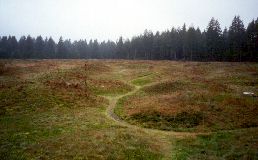

Gopher Theory
 |
It is favorably believed that the origin of the Mima Mounds was wholly the responsibility of the Mazama (northwestern) Pocket Gopher (Thomomys talpoides). |
| Dalhquest and Scheffer, professors from the University of Washington, stated that Mima mounds were formed by pocket gophers or similar animals that tunnel outward from their nest sites, causing the backward displacement of soil. They suggested that the mounds are found where such mammals nest year after year. The nests, and thus the mounds, are at a fixed distance from one another because of territorial requirements. Fossorial rodents, such as pocket gophers, can survive only in high spots where the soil is well drained. If such spots exist, the animals establish their nests in them every year. Since gophers usually dig their foraging tunnels outward, they continually displace soil toward the nest. The soil they mine is pushed backward through the tunnel system before being deposited on the surface or packed into an abandoned chamber. | |
Paul Bunyan
| Paul Bunyan is said to have brought logging to the Pacific Northwest. Not only did he dig Puget Sound, to float huge logs to the mill, he created the mounds at the Mima Prairie. Oh, he also scooped out the Great Lakes to provide drinking water for his giant blue ox, Babe. The legend of Paul Bunyan began with the exaggerated stories and boasts that were exchanged in the bunkhouses of lumber camps from the Great Lakes region to the West Coast. |  |
Seismic Activity
 |
Mima Mounds could instead be the consequence of seismic activity. This was done experimentally by subjecting a plywood board covered with a thin veneer of loess to impacts that produce vibrations in the board. |
| In the experiment, the mounds had characteristics that are similar to those found in the field. This may suggest that most Mima mounds formed as the result of seismic activity in conjunction with unconsolidated fine sediments on a relatively rigid planar substratum. | |